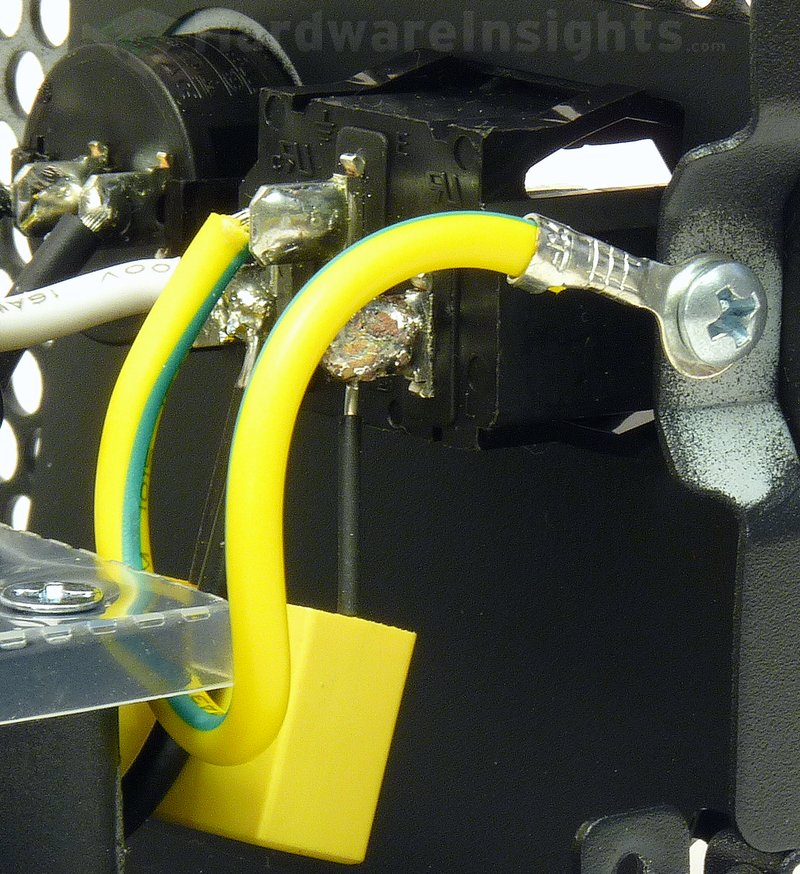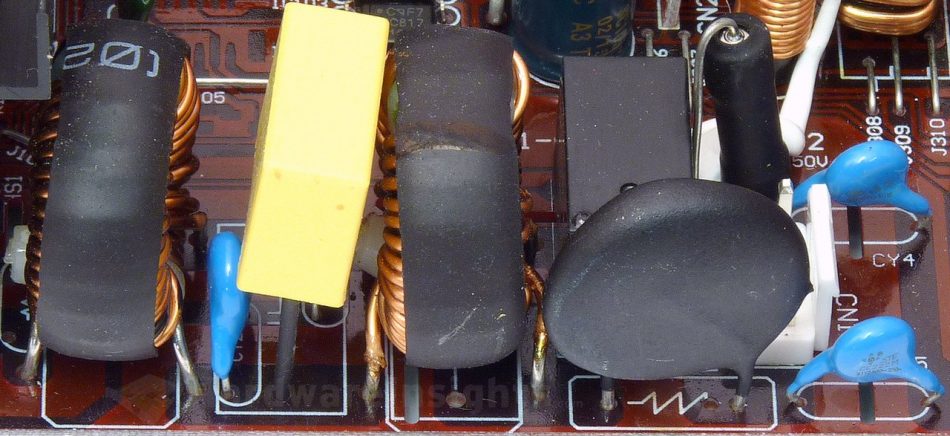Contents
- 1Introducing the Modecom Volcano 750 Gold (ZAS-MC90-SM-750-ATX-VOLCANO-GOLD)
- 1.1Packaging and accessories
- 2Connectors & cabling
- 2.1Casing & cooling
- 3Input filtering
- 4Primary side
- 4.1+5 V stand-by rail
- 5Secondary side
- 5.1Build quality
- 6Load testing
- 6.1Loading +5 V SB
- 6.2Hold-up time
- 6.3Combined loading
- 6.4Combined loading ripple
- 6.5Crossloading, overloading
- 6.6Crossloading, overloading ripple
- 6.7Fan speed, temperatures and noise
- 7Conclusion and evaluation
- 7.1Thanks
- 7.2Discussion
Input filtering
The first stage of the input filtering of the Volcano 750 Gold uses an unshielded AC inlet with a single film X capacitor. There’s only a single-pole AC switch and no ferrite ring. As the casing is somewhat unusual, there is a long cable which leads from the switch to the main board, with a connector. I actually like it as it makes things easier. Usually when the cabling is short as the input filtering is right next to the inlet, it is directly soldered into the board. The capacitor does not carry bleeder resistor though. As the resistors on the board are only after the input fuse, in case the fuse blows this may pose a risk of electric shock. Depending on what energy the capacitor can store and how fast it discharges as per IEC 61010-1.
Then there is one more X cap, four ceramic Y capacitors (with fifth between the primary common and earth ground), two common-mode chokes and also a large thermistor. As you can see, it comes with relay bypass. However, I found no varistor or any other overvoltage protection mechanism (like spark gap). This is clearly a disadvantage for which the unit is getting penalised.
The X capacitors (between the live and neutral) and Y capacitors (between live and ground/neutral and ground) are used to filter out high-frequency ripple that emanates from the power grid. That is the noise of which manifests in the form of feedback from electronic devices which lack adequate filtering due to cost cutting. But also from devices where filtering was very difficult to implement (powerful devices, e.g. microwave ovens). It also prevents ripple from this unit itself from feeding back into the grid.
Chokes are used for the same reason, and together with the X/Y capacitors they form an input filter. Such filters are often made as one component, they may also be integrated together with AC receptacle. These components may also (partially) help to filter smaller voltage spikes in the power grid. To suppress more serious spikes (for example from distant lightning strikes hitting the power grid), the MOV (metal-oxide varistor) is used. Thermistor is then used to suppress current spikes when first connecting the unit to power (i.e. flipping the power switch).
The Y capacitors are also often situated between the high-voltage primary and the low-voltage secondary sides. These days, more Y capacitors are used even between primary common (ground after an input rectifier) and earth ground to suppress internal interference and keep it from getting to the secondary side. It is because really high-frequency ripple goes everywhere it can to some extent (including coupling through the insulation, metal casing etc…). That is also why the AC wires themselves are often inserted through the ferrite toroid inductor (to suppress such coupling).



